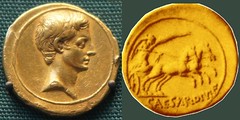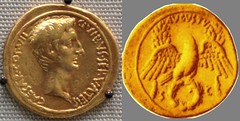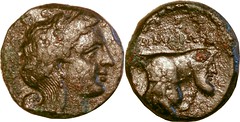Part 20 RRC 544 to RRC 550, 35BC to 27BC, Mark Antony and Octavian Battle of Actium to the end of the Roman Republic

|
Specialist Supplements:
1. Roman Coins of Luceria and Canusium
2. Anonymous Struck Bronze Coins of the Roman Republic
3. Anonymous Roman Republican Denarii and Victoriati (Steve Brinkman's site)
Principal Coins of the Roman Republic
Part 20 RRC 544 to RRC 550, 35BC to 27BC, Mark Antony and Octavian Battle of Actium to the end of the Roman Republic
RRC 544/1 CHORTIVM PRAETORIARVM, ANT AVG IIIVIR RPC, Mark Antony, Legionary Praetorian Cohort aureus.
RRC 544/2 replica LEG III, ANT AVG IIIVIR RPC, Mark Antony, 3rd legion aureus. This is
a modern die-struck replica in gold of an unlisted gold aureus type. It is hardly expected to deceive
given the stylistic deficiencies. Perhaps it was struck as a minting experiment but it is anyways a nice
space-filler. It weighs 7.9 grams, suggesting it is made of almost pure gold.
RRC lists LEG IV, LEG VI, LEG XII, LEG XIV and LEG XIX in gold, each from a single reverse die, but not LEG III.
Given the large scale of his legionary coinage it is perhaps surprising that the gold issues were not struck
in any significant volume, as there were well-established precedents for large volume gold issues by then.
RRC 544/1 CHORTIVM PRAETORIARVM, Mark Antony Legionary Praetorian Cohort denarius.
6 in Delos hoard.
I will not repeat Antony's title ANT AVG IIIVIR RPC in each of the descriptions that follows, but make some points
here. In addition to his Augurate which he seemed very proud of,
he still refers to IIIVIR R.P.C. in these legionary coins of 32BC to 31BC, despite the Triumvirate lapsing
on the fifth anniversary of the 37BC Tarentum agreement. Of course had he been victorious, the Senate would
no doubt have confirmed him in his titles, and confirmed the Donations of Alexandria and other dubious acts.
Any other Imperator would have done as much. In 49BC Pompey brought the Senate and legitimately
elected Consuls with him to Greece. Whether one liked Caesar's motives or not, it was Julius Caesar who acted outside
the law and his triumph was a victory of Realpolitik over legal form.
Octavian was on no better legal grounds, given that his alliance with Antony was
against tyrant killers in the best Republican tradition. Much of Octavian's claims
were regal, based on his position as Caesar's heir.
All that said, Octavian did restore a functioning model
of Republican government after 27BC, with a Senate and Consuls that had stature and probably also
ongoing legislative and advisory duties. After Octavian disposed of those deemed too dangerous, e.g. Antony's son
by his legitimate Roman wife Fulvia, he offered clemency to former enemies including Lepidus, Scarpus, Crassus' grandson,
and Antony's other children. One doubts that Rome would have had anything like 200 years of peace and wealth had
the first Roman emperor been Antony.
RRC 544/9 LEG XII Antiquae, Mark Antony, 12th Old Legion denarius.
5 in Delos hoard.
RRC 544/10 LEG XVII Classicae, Mark Antony, 17th Classic Legion denarius.
8 in Delos hoard. This coin is an odd style, the eagle looks more like a garden bird. Might it be unofficial? It's difficult to
tell as Antony legionary coins come in such varying styles.
RRC 544/11 LEG XVIII LYBICAE, Mark Antony, 18th Lybian Legion denarius.
4 in Delos hoard.
RRC 544/12 CHORTIS SPECVLATORVM, Mark Antony, Investigating Cohort denarius.
9 in Delos hoard. The CHORTIS SPECVLATORVM combined the modern attributes of military police and military scouts.
Sometimes translated
as spies, investigative agency is probably closer to the sense, more FBI than CIA.
RRC 544/14 LEG II, Mark Antony, 2nd Legion denarius. 40 in Delos hoard.
RRC 544/15 LEG III, Mark Antony, 3rd Legion denarius. 25 in Delos hoard.
RRC 544/17 LEG IV, Mark Antony, 4th Legion denarius. 28 in Delos hoard.
RRC 544/16 LEG IIII, Mark Antony, 4th Legion denarius. Zero in Delos hoard. This is the single
rarest legion with ordinary format numbers. In the Delos hoard of 1905, every numbered legion was represented
by at least six examples, except for LEG IIII which had no examples at all, and the odd-format legions
IIX (not in RRC), RRC 544/13 PRI, and RRC 544/34 XVIIII, each also with zero examples.
RRC 544/18 LEG V, Mark Antony, 5th Legion denarius. 37 in Delos hoard.
RRC 544/19 LEG VI, Mark Antony, 6th Legion denarius. 36 in Delos hoard.
RRC 544/20 LEG VII, Mark Antony, 7th Legion denarius. 27 in Delos hoard.
The coin is struck on a short very thick flan and
the galley is of a reduced size and different style, which I have not seen on any other Antony legionary coin.
Both obverse and reverse types are in very high relief. The coin is evidently of good quality silver.
As mentioned in
other places in the Ahala Collection, when you combine differences in flan manufacture, with difference in die
size and differences in design details and engraving style, together that usually points to a different minting
circumstance than the coinage it resembles.
RRC 544/21 LEG VIII, Mark Antony, 8th Legion denarius. 27 in Delos hoard.
RRC 544/22 LEG VIIII, Mark Antony, 9th Legion denarius. 15 in Delos hoard.
RRC 544/23 LEG IX, Mark Antony, 9th Legion denarius. 20 in Delos hoard.
RRC 544/24 LEG X, Mark Antony, 10th Legion denarius. 28 in Delos hoard.
RRC 544/25 LEG XI, Mark Antony, 11th Legion denarius. 24 in Delos hoard.
RRC 544/26 LEG XII: 28 in Delos hoard. RRC 544/27 LEG XIII: 20 in Delos hoard. RRC 544/28 LEG XIIII:
6 in Delos hoard. RRC 544/29 LEG XIV: 12 in Delos hoard. RRC 544/30 LEG XV: 39 in Delos hoard.
RRC 544/31 LEG XVI: 24 in Delos hoard.
RRC 544/32 LEG XVII, Mark Antony, 17th Legion denarius. 22 in Delos hoard.
RRC 544/33 LEG XVIII, Mark Antony, 18th Legion denarius. 6 in Delos hoard.
RRC 544/34 LEG XVIIII: zero in Delos hoard.
RRC 544/35 LEG XIX, Mark Antony, 19th Legion denarius. 16 in Delos hoard.
RRC 544/36 LEG XX, Mark Antony, 20th Legion denarius. 13 in Delos hoard.
RRC 544 retrograde variety GEL IXX, Mark Antony, 21st Legion denarius. This variety
with retograde reverse legend but normal devices and normal obverse, is of Spanish provenance. There is no
sign of it being plated. The style is otherwise entirely official but it is very unlikely that it could be
a mint error. I expect that it is a reduced silver or unseen plated imitation. It's specific gravity is 8.85
which is lower than the specific gravity of silver of 10.4.
RRC 544/37 LEG XXI, Mark Antony, 21st Legion denarius. 23 in Delos hoard.
RRC 544/38 LEG XXII: 15 in Delos hoard.
RRC 544/39 LEG XXIII, Mark Antony, 23rd Legion denarius. 24 in Delos hoard. Despite
the supposed rarity of Legion XXIII, there are plenty of hoard examples. Perhaps this is a popular type as
collectors strive to obtain the highest legion number.
RRC 545 M.ANTONIVS, D.TVR, Mark Antony, Turillia denarius.
RRC 546/2 SCARPVS IMP, M.ANTO, Pinaria Scarpus, Mark Antony denarius.
RRC 546/4 IMP CAESAR DIVI F, Octavian, Pinaria Scarpus denarius. Whoops there's been
a regime change, we better change the coinage quickly! On this coin type that evidently dates after Actium,
Scarpus replaces his name and Antony's name with the name and titles of Octavian, but he keeps the obverse type of
Jupiter Ammon. The reverse copies the Victory on globe type of Octavian's contemporary coinage.
RRC 546/6 IMP CAESARI DIVI F, SCARPVS IMP, Octavian, Pinaria Scarpus denarius.
Scarpus restores his name here, alongside Octavian's.
RRC 546/6 and RRC 546/7 plated hybrid IMP CAESARI SCARPVS IMP, CAESARI DIVI F, Pinaria Scarpus, Octavian denarius.
This plated hybrid coin combines two different forms of Octavian's name and titles on both sides. Given the
relative rarity of RRC 546/6 and the great rarity of RRC 546/7, I suppose this coin to have been made close to, or
in, the place of issue of RRC 546/6 and 546/7.
RRC 546/7 SCARPVS IMP, CAESARI DIVI F, Pinaria Scarpus, Octavian denarius. This
type is very much rarer than the RRC 546/6 IMP CAESAR types.
RRC 546/8 SCARPVS IMP, CAESARI DIVI F, Pinaria Scarpus, Octavian quinarius.
This quinarius, chronologically the last coin in RRC, is one of the great rarities of the Republican series, known
in very few examples.
RRC 550 Q.OPPIVS PR, Oppia dupondius. Evidently this coin belongs to an earlier
time. Refer to the
introductory discussion on the Imperatorial period for the views of Crawford and
Woytek as to whether or not this orichalcum type should be associated with the RRC 476 Clovia dupondius.
RRC 550 Q.OPPIVS PR, Oppia dupondius. This differs from the previous coin in
having a Capricorn behind the head rather than a crescent before the head.
Sear HCRI 262,263 Mark Antony and Octavia cistophori. To discuss the remaining
Imperatorial era coins that are not included in Crawford's RRC, I reference David Sear's "History and
Coinage of the Roman Imperators", in preference to a combination of RIC and RPC references. Students and
collectors of Republican coins are more likely to have Sear's popular book to hand than RIC and RPC. Furthermore
there is a chronological sequence to the issues in Sear HCRI during the Imperatorial period,
that is absent from either RPC or RIC, which books have a different audience and purpose.
RPC is organised geographically. RIC is organised by emperor and geography. Sear HCRI organises the coins by the major
time periods of the civil wars, and within that, by Imperator, and chronologically within each Imperator's issues.
Sear HCRI 315A IMP CAESAR DIVI F, Octavian quinarius.
Sear dates this rare quinarius to 36BC.
Sear HCRI 392 IMP CAESAR DIVI F Octavian denarius. Illyria, about 32BC.
Sear HCRI 394,395,396 CAESAR DIVI F Octavian aureus and denarii. These coins were likely struck by
Octavian in 32BC to 31BC, in his preparations for Actium. The pre-Actium types lack the naval trophy designs
and triumphal images seen after Actium; their types with Venus and the legend DIVI F hark back to Julius Caesar
rather than forwards to Octavian's imperial age. Because all these are of the style of later Roman
Imperial coinage, numismatists did not traditionally associate these with the Roman Republic.
CHV Sutherland's "Octavian's Gold and Silver Coinage from c.32 to 27BC", Quaderni Ticinesi 1976, corrected the
picture and brought these coins back to the Roman Republican era. This rearrangement was memorialised in
Sutherland's revised Roman Imperial Coinage vol.1, 1984.
Sear HCRI 397,399,400,401 CAESAR DIVI F Octavian denarii. A feature of this coinage is that obverse and reverse types alternate on paired coins. On the two coins at right, the first shows Venus' head on the obverse with Octavian walking on the reverse, and its matching type shows Octavian's head on the obverse with Venus seated on a rock on the obverse.
Sear HCRI 403 CAESAR DIVI F Octavian aureus. The aurei of Octavian were produced in quite large quantities.
Sear HCRI 406,407,409 CAESAR DIVI F Octavian denarii.
Sear HCRI 416 IMP CAESAR Octavian denarius. The last coin of this tray
post-dates Actium. There is a change in style to IMP CAESAR, dropping the DIVI F titles, the obverse
shows a triumphal procession, and the Victory on the reverse is now standing on the prow of Actium rather than on
a globe.
Sear HCRI 419,421,422,423 IMP CAESAR Octavian denarii. The triumphal and naval scenes continue on these post Actium coins. The rostral column on the coin at right, i.e. a column with rostrum tridens' on its sides, has been copied at Columbus Circle in New York City, the latter however showing Christopher Columbus at top, rather than a statue of Octavian.
Sear HCRI 424,425,426,427 IMP CAESAR Octavian denarii. The pairing of coin types is again illustrated by the two coins at right, the first showing an obverse bust of Octavian and a terminal column with Octavian's head, above a thunderbolt on reverse, and the second showing a terminal bust of Octavian with thunderbolt on the obverse, and a seated figure of Octavian on reverse.
Sear HCRI 428 IMP CAESAR Octavian denarius.
Sear HCRI 429 CAESAR IMP VII ASIA RECEPTA Octavian quinarius, 28BC. We move on
from the immediate post-Actium coinage to the later coins of Octavian that proclaim his victories in Asia
and Egypt.
Sear HCRI 430 CAESAR COS VI AEGVPTO CAPTA Octavian denarius, 28BC.
Sear HCRI 433 CAESAR COS VI Octavian cistophorus, 28BC to 27BC.
Sear HCRI 430 CAESAR COS VI AEGVPTO CAPTA Octavian denarius, 28BC. Two
attractive examples on display together in the British Museum.
Sear HCRI 435 CAESAR COS VII AVGVSTVS Octavian aureus. This is the last coin
of the Roman Republic. On 1st January 27BC, Octavian became Consul for the seventh time. On the 16th January
27BC, he returned all his powers to the Senate, and they gave him the title Princeps and Augustus. He also
ceased to mint coinage as an Imperator on that date. This therefore is his last coin as an Imperator, and
commemorates his elevation to the title of Augustus.
RRC 1 ROMAION litra. I bookend this presentation of the Ahala Collection by
illustrating the first Roman Republican coin alongside the last.
Specialist Supplements:
1. Roman Coins of Luceria and Canusium
2. Anonymous Struck Bronze Coins of the Roman Republic
3. Anonymous Roman Republican Denarii and Victoriati (Steve Brinkman's site)
All content copyright © 2004-2013 Andrew McCabe unless otherwise noted. If you've any questions or comments please contact me on the Yahoo Group RROME: http://groups.yahoo.com/group/RROME.
Alternately you can leave comments against any coin picture, just click on the picture and write in the comment box.
Site hosted free courtesy of VCoins.com
Ancient Coins on Vcoins
comment: this page is RRC544.html
































